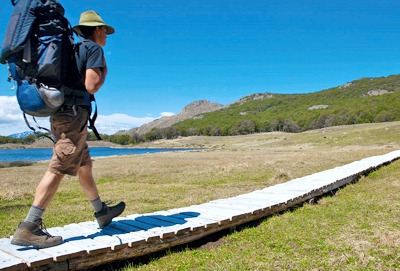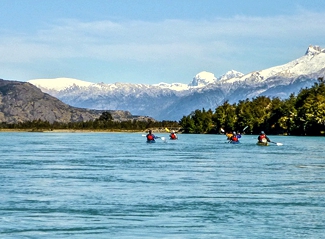

Destinations
Experiences
 |
L
A D A T C O T O U
R S |
 |
||||||||
| HOME | South America | Falkland Islands | Antarctica |
Unique Destinations |
Unique Experiences |
Newsstand | ||||
 |
EXPLORA
PATAGONIA NATIONAL PARK Parque Nacional Patagonia, Aysen Region, Chile FAQs |
 |
EXPLORA PATAGONIA NATIONAL PARK FAQs - in their own words:
| SUGGESTED PACKING LIST | ||
| • Hiking boots • Rain jacket • Rain pants • Down or synthetic insulation jacket • Wool or synthetic base layers |
• Sunscreen, sun hat,
and sun glasses • Warm hat • Headlamp • Insect repellant, particularly during summer • First aid kit |
• Map and compass
|
PARK FAQsQ: What is the best season to visit the park?
A: Patagonia is spectacular all year, with each season having its own attraction. However, October through April are the best months to visit, as those are the warmer, more travel-friendly times with ample daylight. Spring starts in September (late October–early December) and fall (March-April) are particularly beautiful. Summer (late December–February) is warmer and pleasant, but this is the high season and very busy. The Lodge and campgrounds are open from October to April. In winter, driving conditions on the Carretera Austral road can range from slow to dangerous, primarily due to ice and mud.
Q: Can the restaurant and lodge accommodate dietary restrictions?
A: Yes! We can accommodate dietary restrictions including vegetarian, vegan and gluten-free. Please give us advance notice as our remote location makes getting alternative food more complicated.
Q: Can the Lodge accommodate groups?
A: Yes! The Lodge is well-appointed appointed for large groups of family and friends or organized travel groups. Please contact us to inquire about booking the whole lodge or planning a customized visit for your group.
Q: Are the Lodge and campgrounds suitable for children?
A: While we do not have a kid-focused program, children generally love their time at the park—watching wild guanacos, taking short hikes, and getting to know our team.
Q: What can I expect for weather?
A: During summertime, the weather at the park tends to be fairly warm and dry, with highs around 21/27 ºC (70s ºF) during the day, dropping to about 10ºC (50ºF) at night. During spring (November-December) and fall (April-May), daytime temperatures tend to be 10-15 ºC (50s and- 60s ºF), dropping to minus 1-4ºC (30s- and 40s ºF) at night. Be prepared for rapid changes in temperature, as well as rain and substantial wind!
Q: Will there be wi-fi or cell signal?
A: There’s no cell signal at the Lodge, or anywhere in the park, although you may find some in Puerto Bertrand or Cochrane on your travels to and from the park. Lodge visitors do have access to wi-fi, however, the connection is slow and can be sporadic. Please do not plan on streaming video.
Q: Is there a general store and/or gift shop?
A: The Patagonia Park store sells local crafts such as wool sweaters, hats, and blankets, wooden kitchenware, and natural honey, as well as books, maps, t-shirts, and other park goods. There is nowhere to buy groceries within the park. The nearest town, Cochrane, is 30 minutes away and has several general stores.
Q: Can I visit the park when the Lodge and facilities are closed?
A: In winter the roads to and in the park can become muddy, icy, and dangerous, depending on the weather. It is not uncommon for cars to get stuck, and there is minimal assistance in case of emergency. The park is technically open to visitors and backpackers even when our facilities are closed; however, we recommend you do take extreme caution before driving to the park in winter.
Q: Is there a park entrance fee?
A: No, currently there is no entrance fee to access the park. There is a fee for Lodge and campgrounds guests, which can be paid at headquarters.
Q: How big is the park?
A: Currently, Patagonia Park encompasses nearly 200,000 acres of grasslands and forests in the Chacabuco Valley. This acreage abuts two existing reserve areas, the Jeinimeni and Tamango National Reserves, which cover around 450,000 acres. Our conservation plan calls for joining Patagonia Park with Tamango and Jeinimeni, creating a national park that will total 650,000 acres, or 263,000 hectares. For comparison’s sake, the vast Yosemite National Park in California is just a bit larger in size, coming in at 761,600 acres. The future Patagonia National Park project is 1.5x the size of Torres del Paine National Park, the best-known and most visited park in Chilean Patagonia.
Q: Is smoking allowed in Patagonia Park?
A: Smoking is prohibited inside the lodge, restaurant and in wilderness areas. When you arrive you may consult with staff on where to find established smoking areas. Patagonia Park is a vast grassland ecosystem that can easily catch on fire. In the winter of 2014, 2,800 hectares were burned in the valley and the flames came up just a kilometer away from the park facilities. Since our location is very remote, there were people from all over the area who risked their lives fighting full days (and long nights) to protect wildlife, homes and park. We appreciate your respect for the land and its inhabitants.
Q: Is there electricity throughout the day on the premises of Patagonia Park?
A: The electricity in the lodge operates from 7am to midnight. Lodge rooms contain lanterns and candles (220-240 volts)